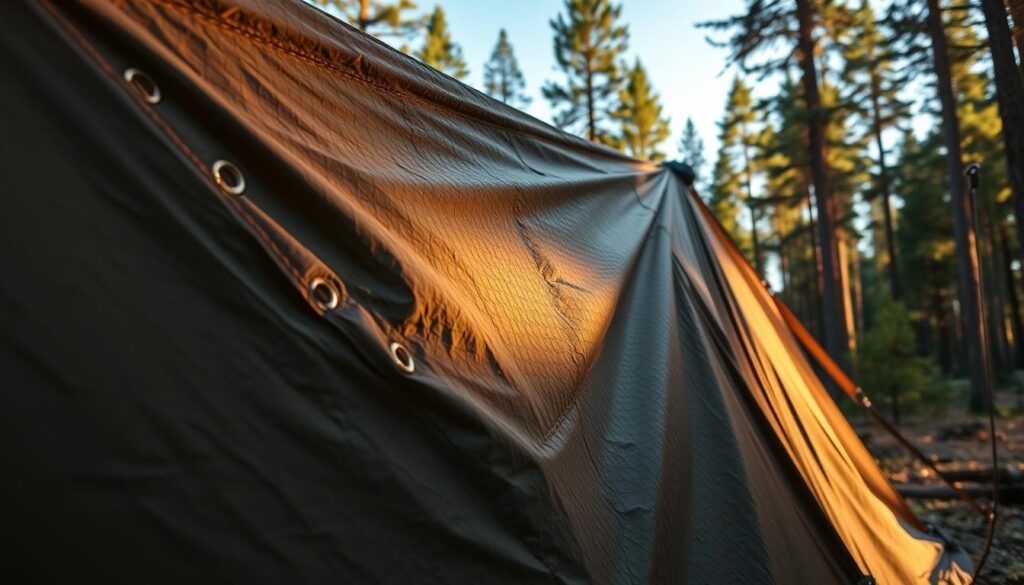As someone who loves the outdoors, I know how key the right gear is. A weather-resistant cover is a must-have for me. It’s a vital part of my outdoor camping gear.
A shelter tarpaulin keeps me safe from the weather. It lets me explore even when it’s tough outside. Learning how to use it well makes any outdoor trip better, whether camping, hiking, or backpacking.
Key Takeaways
- Understand the benefits of using a weather-resistant cover for outdoor activities.
- Learn how to properly set up a shelter tarpaulin for maximum protection.
- Discover the versatility of shelter tarpaulins in various outdoor scenarios.
- Enhance your outdoor experience with the right outdoor camping gear.
- Master the techniques for securing a tarpaulin in different weather conditions.
Introduction to Shelter Tarpaulins
Shelter tarpaulins are key for outdoor lovers, like campers and hikers. They offer lightweight protection from the weather. I find them essential for being ready for anything.
What Is a Shelter Tarpaulin?
A shelter tarpaulin, or tarp, is a waterproof sheet. It’s made from materials like canvas or polyethylene. It’s tough and keeps out rain, wind, and sun.
For survival shelter building, knowing about tarps is vital. Check out my guide on crafting a reliable survival shelter.
Purpose and Uses of Tarpaulins
Tarpaulins have many uses. They can be an emergency shelter or protect vehicles or gear. They’re a must-have for outdoor fans and those ready for surprises.
Whether camping or fixing a leaky roof, a tarp can save the day.
Key Features to Consider
When picking a tarp, look at its material, size, weight, and water resistance. A durable tarp that’s also light is perfect for backpacking or emergency kits. Look for tarps with reinforced edges and grommets for better use and longer life.
Knowing about shelter tarpaulins helps prepare for outdoor fun and unexpected events. It ensures you have the lightweight protection you need.
Choosing the Right Shelter Tarpaulin
Choosing the perfect shelter tarpaulin is important. It can greatly improve your outdoor experience. Whether you’re camping, preparing for emergencies, or protecting your vehicle, the right tarp makes a big difference.
Material Types: Canvas vs. Polyethylene
The material of your tarp is key for its durability and effectiveness. Canvas tarps are breathable and durable, great for long-term use. Polyethylene tarps are waterproof and cheaper, perfect for temporary shelters or where moisture is a concern.

| Material | Breathability | Water Resistance | Durability |
|---|---|---|---|
| Canvas | High | Medium | High |
| Polyethylene | Low | High | Medium |
Size and Coverage Considerations
The size of your tarp is critical. You need to choose a tarp that covers the area you need. A heavy-duty tarp that’s too small won’t protect you well. One that’s too large is hard to secure and may be cumbersome.
Weight and Portability Factors
The weight and portability of your tarp are also important. If you’ll be carrying it, a lighter tarp is better. But, lighter tarps may not last as long as heavier ones. You need to find a balance between portability and durability.
In conclusion, picking the right shelter tarpaulin involves looking at material, size, and weight. By choosing wisely, you can have a more comfortable and safe outdoor experience.
Essential Tools for Using a Shelter Tarpaulin
To get the most out of a shelter tarpaulin, you need the right tools. Whether you’re camping, preparing for emergencies, or doing other outdoor activities, the right gear is key. It makes your shelter more effective and lasts longer.
The Importance of Proper Tools
The right tools make setting up your shelter tarpaulin easier. They also keep it secure and working well. Outdoor camping gear like stakes, ropes, and poles is a must. These items work with a durable tarp to create a solid shelter.
Recommended Tools for Setup
Here are the main tools you’ll need to set up a shelter tarpaulin:
- Ropes or twine for tying down the tarpaulin
- Stakes or anchors to secure the tarpaulin to the ground
- Poles or masts to support the structure
- A mallet or hammer for driving stakes into the ground
These tools are vital for a stable and weather-resistant cover. The quality of these tools greatly affects your shelter tarpaulin’s performance and life span.
Maintenance Tools
To keep your shelter tarpaulin in top shape, you’ll need some maintenance tools:
| Tool | Purpose |
|---|---|
| Cleaning solution | For removing dirt and grime |
| Repair kit | For fixing tears or damages |
| Storage bag | For protecting the tarpaulin when not in use |
Regular maintenance extends your tarpaulin’s life and keeps it effective. I always check my tarpaulin after each use. I fix any damage to keep it in the best condition.
Setting Up Your Shelter Tarpaulin
Setting up a shelter tarpaulin is key for a reliable emergency shelter. It offers lightweight protection against the weather. This makes it essential for outdoor lovers and those needing quick shelter.
Step-by-Step Setup Process
To set up your shelter tarpaulin right, follow these steps:
- Find a flat spot with few obstacles.
- Spread out your tarpaulin, making sure it covers enough area.
- Secure the tarpaulin with ropes or twine to nearby objects like trees or poles.
- Make sure the tarpaulin is tight to stop sagging and let water run off.
Outdoor experts say, “A well-set-up tarpaulin can make all the difference between a good camping trip and a bad one.”
“The key to a successful tarpaulin setup is in the details, from the choice of location to the tensioning of the fabric.”
Choosing the Perfect Location
Finding the right spot is vital for your shelter tarpaulin’s stability and effectiveness. Look for a place that is:
- Flat and dry to avoid water buildup.
- Protected from strong winds and harsh weather.
- Close to water, but not too close to avoid flooding.

Safety Precautions During Setup
Always put safety first when setting up a shelter tarpaulin. Watch out for hazards like:
- Overhanging branches that could fall and hurt you.
- Nearby water bodies that could flood or attract wildlife.
- Unstable ground that could make the tarpaulin collapse.
By following these safety tips and setting up your shelter tarpaulin correctly, you can create a safe and secure emergency shelter.
Securing Your Shelter Tarpaulin
To keep your waterproof tarp in place, securing it right is key. A well-attached tarpaulin offers better protection and lasts longer.
Effective Tying Techniques
Start by using the right knots to secure your durable tarp. The bowline knot and clove hitch are top choices for tarps. They help your tarp stand up to wind and rain.
Make sure your knots are tight and spread out evenly. This spreads the tension, preventing sagging or tears.
Best Practices for Windy Conditions
When it’s windy, securing your versatile shelter solution is even more important. Add extra guy lines for support and stability. Anchor these lines to trees, rocks, or stakes.
Also, angle your tarp to let wind slide over it. This reduces the chance of it being lifted or torn. Always check the tarp’s tension and adjust as needed.
Utilizing Stakes and Weights
Stakes and weights are great for securing your tarpaulin. Use heavy-duty stakes for ground anchorage. Drive them in at an angle for better grip.
If staking is hard, like on hard surfaces, use weights instead. Sandbags or heavy objects on the tarp’s edges keep it in place.
By using the right tying techniques, following windy weather tips, and employing stakes and weights, your tarpaulin stays secure. This makes it a reliable versatile shelter solution in many situations.
Tarpaulin Maintenance Tips
To keep your heavy-duty tarp in top shape, regular care is essential. A well-kept shelter tarpaulin lasts longer and works better in all weather.
Proper care includes cleaning and storing your tarpaulin right. Always clean it after each use to remove dirt and debris. This prevents damage over time.
Cleaning and Storing Your Tarpaulin
For cleaning, use mild soap and water on your shelter tarpaulin. Stay away from harsh chemicals that can harm the material. Make sure it’s dry before storing to avoid mold and mildew.
Keep your tarpaulin in a cool, dry spot, out of sunlight. Folding or rolling it neatly helps avoid creases and damage.

Identifying and Repairing Damage
Check your outdoor camping gear, like your tarpaulin, often for wear and tear. Look for tears, holes, or weak spots that could harm its strength.
For small damages, use repair kits made for tarpaulins. These kits have patches and adhesive. Apply the patch firmly to seal it well and keep water out.
Prolonging the Lifespan of Your Tarpaulin
To make your heavy-duty tarp last longer, avoid extreme temperatures and sharp objects. They can cause damage or punctures.
Using your tarpaulin correctly and following the maker’s advice also helps. By doing these things, you can enjoy your shelter tarpaulin for many outdoor trips.
Versatile Uses of Shelter Tarpaulins
Shelter tarpaulins are not just for camping. They are useful in many ways because of their durability and ability to withstand weather. They are a must-have for different situations.
Temporary Shelter for Camping
Camping is a big use for shelter tarpaulins. They keep you dry and comfy by blocking the weather. You can use them as a roof, wall, or even a ground cover.
Vehicle Protection from the Elements
They also protect cars from bad weather. A heavy-duty tarpaulin can keep your car safe from rain, snow, and sun. This helps keep your car in good shape for longer.
Outdoor Events and Gatherings
Outdoor events like weddings and festivals need shelter. Tarpaulins can create shaded spots, keep food and drinks dry, or add to the decor. They are easy to set up and take down.
Here’s a quick look at how shelter tarpaulins are used in different ways:
| Application | Benefits | Key Features |
|---|---|---|
| Camping Shelter | Weather protection, dry and comfortable environment | Waterproof, durable |
| Vehicle Protection | Protection from rain, snow, UV rays | Heavy-duty material, secure fastening options |
| Outdoor Events | Temporary shelter, shade, decoration | Easy setup, versatile design |
In short, shelter tarpaulins are a versatile shelter solution for many needs. They are great for camping, protecting cars, and for outdoor events. Their weather-resistant cover makes them a key item for outdoor activities.
Emergency Uses for Tarpaulins
Tarpaulins are key in emergency preparedness. They offer lightweight protection and are a must-have in any emergency kit.
In emergencies, making a shelter is a top priority. A shelter tarpaulin can help create a simple, yet effective shelter. It keeps people safe from rain, wind, and sun.
Creating a Shelter in Crisis Situations
First, find a good spot for your shelter. Look for a flat area with some natural protection. Then, use the tarpaulin over a frame, like a fallen tree, and tie it down with ropes or weights.
First Aid and Safety Applications
Tarpaulins are also useful for first aid and safety. They can be used as a stretcher or to keep injured people dry. Plus, they can help signal for help or block out the view in emergencies.
Tarpaulin as a Ground Cover
Another great use is as a ground cover. A tarpaulin on the ground makes a dry spot to sit or lie down. This is very helpful in wet or damp places.
In summary, tarpaulins are very useful in emergencies. They can be used for shelter, first aid, or as a ground cover. A shelter tarpaulin is a simple yet effective tool that boosts safety and comfort in crisis times.
Environmental Considerations
It’s important to think about the eco-friendly side of shelter tarpaulins. They’re used for camping and emergency shelters. We need to know how they affect our planet.
Eco-Friendly Tarpaulin Options
Recently, there are more eco-friendly tarpaulins available. They’re made from recycled materials or biodegradable plastics. This is good for those who want to be kinder to the environment.
Eco-friendly tarpaulin options include:
- Tarpaulins made from recycled materials
- Biodegradable tarpaulins
- Tarpaulins that last longer, so you don’t need to replace them as often
Recycling and Disposal of Old Tarpaulins
It’s key to recycle and dispose of old tarpaulins right. Many are made from plastics that take ages to break down. Recycling programs for tarpaulins are starting to pop up, letting people send in their old ones for recycling.
Experts say, “Recycling plastic products like tarpaulins is vital. It helps prevent pollution and saves natural resources.”
“The way to lessen tarpaulins’ environmental harm is through design, use, and recycling. By picking recycled materials and recycling them when they’re done, we can cut down their impact a lot.”
Reducing Environmental Impact
There are ways to lessen the harm tarpaulins do to the environment. Picking durable, long-lasting ones made from quality materials helps. Also, taking care of them by cleaning and storing them right can make them last longer.
| Strategy | Description | Environmental Benefit |
|---|---|---|
| Choose durable tarpaulins | Selecting tarpaulins made from high-quality, weather-resistant materials | Reduces the need for frequent replacements, minimizing waste |
| Proper maintenance | Regular cleaning and correct storage of tarpaulins | Extends the lifespan of tarpaulins, reducing the frequency of replacements |
| Eco-friendly disposal | Participating in tarpaulin recycling programs or properly disposing of old tarpaulins | Prevents environmental pollution and conserves natural resources |
By using these strategies and thinking about the environment, we can enjoy tarpaulins without harming the planet.
Conclusion and Final Thoughts
Shelter tarpaulins are key for outdoor lovers and those ready for emergencies. They’re not just fabric; they’re a trusted friend for camping and a shield against bad weather. They’re a must-have for anyone who loves the outdoors.
Key Takeaways
The right shelter tarpaulin can change your outdoor adventures. It’s all about picking the right material, size, and setting it up right. Keeping it in good shape is also important.
Putting Shelter Tarpaulins to Use
I suggest adding a shelter tarpaulin to your outdoor kit. It’s great for campers and those preparing for emergencies. It offers safety and peace of mind when you need it.
A Personal Touch
I’ve learned a lot from using shelter tarpaulins. They’re invaluable in unexpected situations. My camping trip showed me how important it is to be ready with the right gear.
FAQ
What is a shelter tarpaulin, and what are its primary uses?
A shelter tarpaulin is a waterproof sheet. It’s used for shelter, protection, and coverage in outdoor activities. This includes camping, emergency situations, and outdoor events.
What are the key features to consider when choosing a shelter tarpaulin?
When picking a shelter tarpaulin, look at its material (canvas or polyethylene), size, weight, durability, and weather resistance. Make sure it fits your needs.
How do I set up a shelter tarpaulin, and what are the essential tools required?
To set up a shelter tarpaulin, pick a good spot. Use stakes, ropes, and poles. Follow a step-by-step guide. You’ll need strong stakes, weather-resistant ropes, and adjustable poles.
How can I secure my shelter tarpaulin in windy conditions?
To keep your tarpaulin secure in wind, use good tying techniques, stakes, and weights. Heavy-duty tarps and reinforced ropes can also help.
What are the benefits of using a waterproof and heavy-duty tarp?
Waterproof and heavy-duty tarps offer top protection against weather. They’re durable and can handle harsh conditions. They’re great for emergencies and long outdoor use.
How do I maintain and prolong the lifespan of my shelter tarpaulin?
To keep your tarpaulin in good shape, clean and store it right. Fix any damage and reduce environmental impact. Use eco-friendly options and recycle old tarps.
Can shelter tarpaulins be used for purposes other than providing shelter?
Yes, shelter tarpaulins have many uses. They can protect vehicles, cover outdoor events, and serve as ground cover in emergencies.
Are there eco-friendly shelter tarpaulin options available?
Yes, there are eco-friendly tarpaulins made from recycled materials or designed sustainably. They help reduce environmental impact.
How do I recycle or dispose of an old shelter tarpaulin?
To recycle or dispose of an old tarpaulin, consider repurposing it or recycling through local programs. Dispose of it responsibly, like in a landfill or hazardous waste facility.



